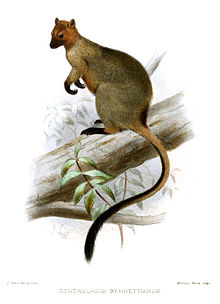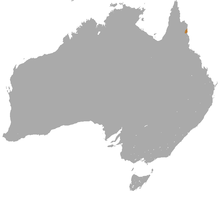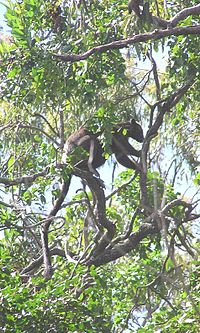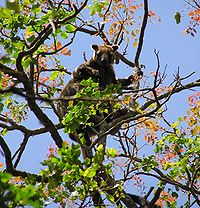- Bennett's Tree-kangaroo
-
Bennett's Tree-kangaroo[1] 
Conservation status Scientific classification Kingdom: Animalia Phylum: Chordata Class: Marsupialia Order: Diprotodontia Family: Macropodidae Genus: Dendrolagus Species: D. bennettianus Binomial name Dendrolagus bennettianus
De Vis, 1887
Bennett's Tree Kangaroo range Bennett's Tree-kangaroo, or Dendrolagus bennettianus, is a large tree-kangaroo. Males can weigh from 11.5 kg up to almost 14 kg (25 to 31 lbs), while the females range between about 8 to 10.6 kg (17.6 to 23 lbs). They are very agile and are able to leap 9 metres (30 ft) down to another branch and have been known to drop as far as 18 metres (59 ft) to the ground without injury.[3]
Contents
Habitat
This very elusive (or "cryptic") tree-kangaroo is found in both mountain and lowland tropical rain forests south of Cooktown Queensland to just north of the Daintree River; an area of only about 70 km by 50 km (44 miles by 31 miles). It is also occasionally found in sclerophyll woodlands. It lives almost completely on the leaves of a wide range rainforest trees, notably Schefflera actinophylla (the Umbrella Tree), vines, ferns and various wild fruits.[4]
Now that it is rarely hunted by Aborigines, its main predators are pythons and the dingo. It is thought to be the closest Tree-kangaroo to the ancestral form.[5][6]
Physical description
Like other tree-kangaroos it has longer forelimbs and shorter hindlimbs than terrestrial kangaroos and a long bushy tail. It is mostly dark brown above and lighter fawn on chin, throat and lower abdomen. The forehead and muzzle are greyish. The feet and hands are black. The tail has a black patch at the base and a light patch on the upper part. The ears are short and rounded
Conservation status
Although the IUCN still rates the status of Bennett's Tree-kangaroo as "Near Threatened",[2] its numbers seem to be increasing and its range expanding. Sightings have become far more common in recent years. In 2006 a dead specimen was found along Amos Bay Road, just south of Cooktown. The increases in numbers and range are likely because most of its range is now protected under World Heritage legislation, and it is no longer hunted by Aboriginal people. Both Roger Martin and Lewis Roberts, two of the world's top experts on this species, agree that it should now be classified as "secure."[7]
Footnotes
- ^ Groves, C. (2005). Wilson, D. E., & Reeder, D. M, eds. ed. Mammal Species of the World (3rd ed.). Baltimore: Johns Hopkins University Press. pp. 59. OCLC 62265494. ISBN 0-801-88221-4. http://www.bucknell.edu/msw3.
- ^ a b Winter, J., Burnett, S. & Martin, R. (2008). Dendrolagus bennettianus. In: IUCN 2008. IUCN Red List of Threatened Species. Downloaded on 28 December 2008. Database entry includes justification for why this species is listed as near threatened
- ^ Cronin (2000).
- ^ Martin (2005).
- ^ Martin et al (1996), pp. 94-95.
- ^ Nguyen, H. (2000). "Dendrolagus bennettianus". Animal Diversity Web. http://animaldiversity.ummz.umich.edu/site/accounts/information/Dendrolagus_bennettianus.html. Retrieved 2006-11-25.
- ^ Martin (2005).
References
- Cronin, Leonard (2000). Australian Mammals: Key Guide (Revised Edition). Envirobooks. Annandale, Sydney, Australia. ISBN 0-85881-172-3.
- Martin, Roger, et al. (1996). Tree Kangaroos: A Curious Natural History. Reed Books, Port Melbourne, Vic., Australia. ISBN 0-7301-0492-3.
- Martin, Roger (2005). Tree-kangaroos of Australia and New Guinea. CSIRO Publishing, Collingwood, Vic., Australia. ISBN 0-643-09072-X.
External links
Categories:- IUCN Red List near threatened species
- Mammals of Queensland
- Macropods
- Marsupials of Australia
Wikimedia Foundation. 2010.



